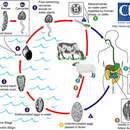en
names in breadcrumbs


Fasciolidae is a family of trematodes and includes several parasites involved in the veterinary and medical sciences, which cause the disease Fasciolosis. Fasciolidae is divided into five genera by Olson et al. 2003. The family's various species are localised in liver, gall bladder, and intestine. Their life-cycle includes an intermediate host, freshwater snails from the family Lymnaeidae.[1]
Adult trematodes of Fasciolidae range in length from 2 cm, for species of Parafasciolopsis, and 10 cm, for species such as Fasciola gigantica. The oral and ventral suckers are usually located. the cercariae are of a gymnocephalic shape.[2]
According to Olson et al. 2003 [3] the family has five genera:
Fasciolidae is a family of trematodes and includes several parasites involved in the veterinary and medical sciences, which cause the disease Fasciolosis. Fasciolidae is divided into five genera by Olson et al. 2003. The family's various species are localised in liver, gall bladder, and intestine. Their life-cycle includes an intermediate host, freshwater snails from the family Lymnaeidae.